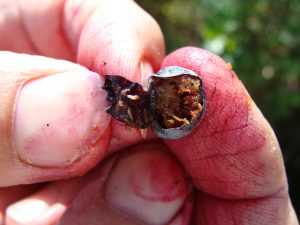Spotted Wing Drosophila Update: July 24, 2020
SPOTTED WING DROSOPHILA UPDATE: JULY 24, 2020
Click on photos to enlarge.
David Handley, Vegetable and Small Fruit Specialist; James Dill, Pest Management Specialist, Christina Howard, Produce Safety Professional

Spotted wing drosophila (SWD) fruit fly numbers have been increasing over the past week in most of the sites that we are monitoring. Due to various restrictions on our monitoring program as a result of the COVID-19 pandemic, we have had to reduce the number of sites we are monitoring this season, but the sites we are able to maintain will hopefully give us a good representation of what is happening around the Southern and Mid-Coast regions with spotted wing drosophila populations.
SWD counts this week have climbed to levels that are considered potentially damaging to ripening berry crops, especially raspberries and blueberries (see table below).

Research suggests that when six to ten flies are caught in a yeast-baited trap in a week, larvae will start appearing in the fruit. Sites capturing more than four SWD flies in a week should remain on a protective spray schedule to prevent fruit from becoming infested with larvae. A seven-day spray interval should be adequate in most situations, but a five day interval may become necessary if larvae continue to be present in fruit with the seven day interval. Be sure to read and follow all pesticide product labels carefully, especially in regards to days to harvest restrictions and the number of applications allowed per growing season. Rotate products used regularly to prevent the possible development of resistance.

We expect populations to increase in the coming weeks as more food (fruit) becomes available for the flies, especially if conditions remain warm and humid. Berry growers should set out traps to monitor SWD populations in their fields. Start protective sprays on any berries that have begun to ripen, when more than four spotted wing drosophila flies are caught in a trap, or any larvae are noticed in the fruit. Look for fruit flies hovering around fruit and symptoms of premature fruit decay. The flies are most prevalent in the lower, shaded parts of the plants.
Current information on registered pesticides for managing SWD is available in the New England Small Fruit Management Guide. The online version is free and can be viewed here:
New England Small Fruit Management Guide
For more information on identifying spotted wing drosophila (SWD) and updates on populations around the state, visit our SWD blog
Other IPM Web Pages:
Michigan State University
David T. Handley
Vegetable and Small Fruit Specialist
Highmoor Farm Pest Management Unit
P.O. Box 179 17 Godfrey Drive
Monmouth, ME 04259 Orono, ME 04473
207.933.2100 1.800.287.0279
Where brand names or company names are used it is for the reader’s information. No endorsement is implied nor is any discrimination intended against other products with similar ingredients. Always consult product labels for rates, application instructions and safety precautions. Users of these products assume all associated risks.
The University of Maine is an equal opportunity/affirmative action institution.
| Town | Spotted Wing Drosophila weekly trap catch 7/17/20 | Spotted Wing Drosophila weekly trap catch 7/24/20 |
|---|---|---|
| Wells | 8 | 21 |
| Sanford | 0 | 2 |
| Limington | 2 | 8 |
| Cape Elizabeth | 1 | |
| Bowdoinham | 18 | 371 |
| Mechanic Falls | 0 | |
| Monmouth* | 5 | 15 |
| Wayne | 13 |
*unsprayed planting
